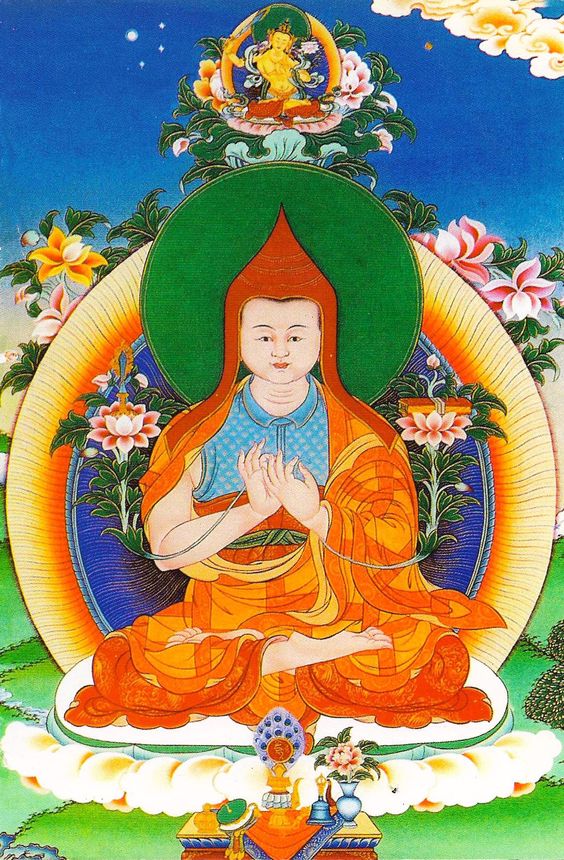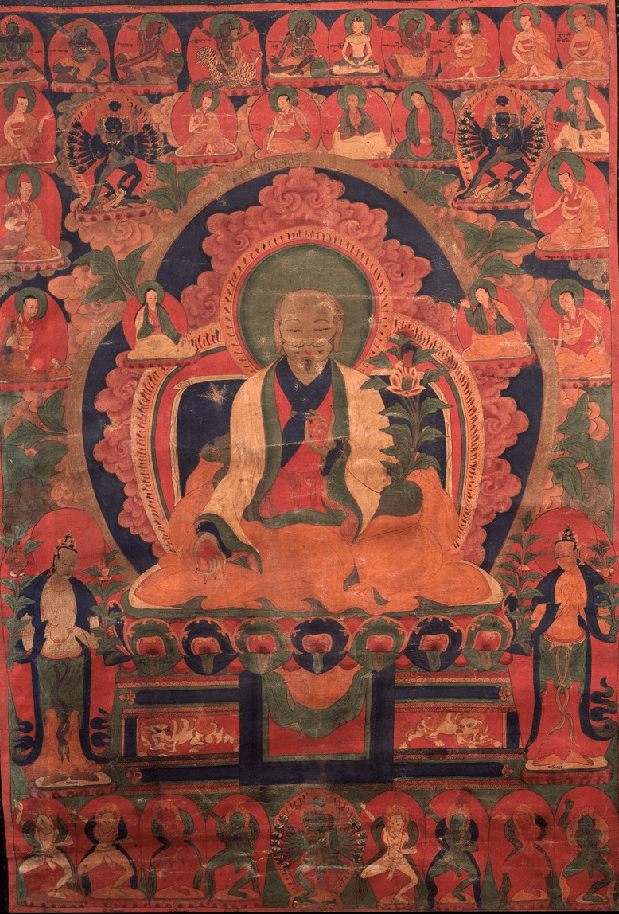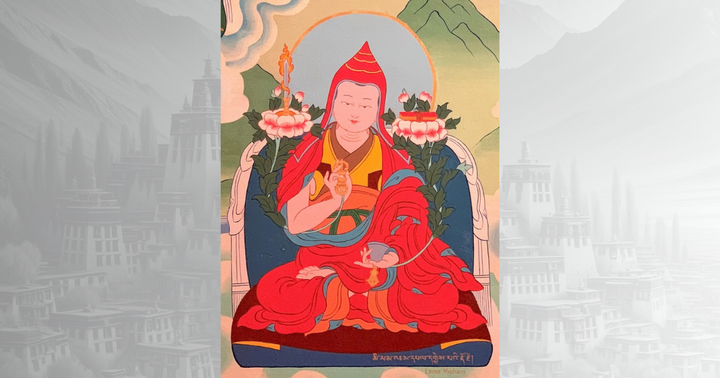Fully Seeing the Profound: A Commentary on the Verses of the Heart Essence of Dependent Origination
Extensive and invisible, the web of dependent origination. Thoroughly binds beings throughout all realms of existence. This path that sets them free, taught by the great Śramaṇa. Cannot be found in the Brahma world or elsewhere.

by Mipham Rinpoche
Namo guru padma mañjuśrī vajratīkṣṇāya!
Extensive and invisible, the web of dependent origination
Thoroughly binds beings throughout all realms of existence.
This path that sets them free, taught by the great Śramaṇa
Cannot be found in the Brahma world or elsewhere.
For this reason, with heartfelt respect,
I pay homage to and honour at the crown of my head
The incomparable teacher and his heirs, who followed in his footsteps.
Now, I shall elucidate that unsurpassable path
Taught by the Buddha.
Dependent origination is the heart essence of all the teachings of the victorious Lion of the Śākyas. As the teacher Nāgārjuna said:
Dependent origination
Is the precious profound treasure of the speech of the Victorious One.
Whoever sees it completely
Sees the supreme knowledge of the Buddha.
This accords with the scriptures in the sūtra collection taught by the Buddha himself. In a commentary on the intent of the discourse of dependent origination, the Victorious One prophesied that it would be the noble protector Nāgārjuna who would clarify the unsurpassed vehicle.
This text, which clarifies the immaculate speech of the glorious lord Nāgārjuna, the Verses of the Heart Essence of Dependent Origination, has three parts: the meaning of the introduction, the meaning of the main part, and the meaning of the conclusion.
1. Introduction
a. The title
b. The homage of the translator
1.a) The title
In the language of India: pratītyasamutpāda hṛdaya kārikā.
In the language of Tibet: rten cing ‘brel bar ‘byung ba’i snying po tshig le’ur byas pa.
The correspondence between the two languages is as follows: pratītyasamutpāda corresponds to rten cing ‘brel par ‘byung ba’i (of dependent origination), hṛdaya corresponds to snying po (heart essence), and kārikā corresponds to le’ur byas pa (verses).
The meaning is that, just as butter is produced from milk, this is the heart essence because it brings together the meaning of the various sūtras on dependent origination taught by the Victorious One and represents the complete realization of all the profound key aspects of those sūtras. In other words, it gathers together what is extensive and its understanding is profound. This meaning is written in the form of verses, so it is stated thus.
1.b) The homage of the translator
I bow down to the youthful child of the Victorious Ones who is gentle due to being free from coarse negative emotions and who, having exhausted the cognitive obscurations, is fully endowed with the glorious twofold knowledge. This is the homage of the translator.
2) Main part
The Victorious One taught dependent origination extensively in many discourses, such as the Salu Sprout Sūtra[1] and others. In general, all discourses of the Buddha, whether from the lesser or greater vehicle, must be relatable to the four noble truths. Indeed, all the discourses that the Buddha taught are alike, insofar as they cut through cyclic existence at its root and cause one to enter nirvāṇa. And each of these features, moreover, are definitively counted as two —corresponding to their subdivision into cause and effect. This is why it is explained that the teachings of the Victorious One begin with the four noble truths, which serve as the foundation for the entire sacred Dharma. It is our unsurpassed tradition which comprehends what may bring cyclic existence to its end.
As such, you might wonder from what cause saṃsāra, which is by nature suffering, arises. And what are the means whereby you might achieve liberation from this suffering. Non-Buddhists, in their confusion, believe that they will be liberated by the likes of Brahma or Īśvara, or by meditation upon the ātman and so forth. There are many such falsehoods, contrived under the influence of confusion.
The authentic Victorious One, the perfect Buddha, explained “all phenomena, internal and external, appear due to the dependent origination of causes and conditions. The causes for the origin of the impure world of the outer environment and its inhabitants are karma and negative emotions.” The method that reverses this is said to be the path which brings cyclic existence to its cessation. Thus, it is the Wheel of Dharma, the unsurpassable great path, which was previously unknown even to the likes of Brahma.
So, what is this profound dependent origination? In Sanskrit its essential meaning is expressed as: ye dharmā hetu prabhavā hetun teṣāṃ tathāgato hy avadat teṣāṃ ca yo nirodha evaṃ vādī mahāśramaṇaḥ
In translation, this reads as follows:
All phenomena arise from causes,
And those causes have been taught by the Tathāgata.
That which brings about the cessation of those causes,
That too has been taught by the great Śramaṇa.
As this verse succinctly conveys, all phenomena do not arise by virtue of their own essence, without a cause. Rather, each phenomenon arises based upon the dependent origination of its own causes and conditions. Furthermore, phenomena are not created by time, Īśvara, and so forth, as non-Buddhist traditions maintain. In fact, they arise from specific causes, as the Tathāgata explained in the Sūtra of Dependent Origination when stating that if such and such exists, such and such will arise; if such and such does not, such and such will not. The verse also states that it was only the great Śramaṇa, the Buddha Bhagavān, who taught the path that leads to the attainment of nirvāṇa, the result of cessation, by showing the unmistaken path which is the method for reversing and bringing to a stop the cause of the all-pervasive afflictive emotions. There is no other who speaks of this anywhere in the world, including in the realm of the gods.
The explanation of the meaning of dependent origination has six sections:
- Identifying the essence of the twelve links of dependent origination
- How these are divided into three categories
- Teaching on the meaning of dependent origination
- Explanation of the meaning of dependent origination as emptiness
- Establishing this by means of analogies
- Instruction on liberation through perceiving suchness which is dependent origination free from the two extremes
1. Identifying the essence of the twelve links of dependent origination
This explanation proceeds from ‘the different links’ up until ‘taught’.[2]
There are twelve distinct, individual links that refute the many extremes regarding cause and result which are within the sphere of the all-pervasive afflictive emotions. Given that they arise in mutual interdependency Śākyamuni Buddha, the Bhagavān, taught these twelve as the meaning of dependent origination.
Accordingly, one may wonder what is it to say that because this exists then that arises? Formations and the others arise due to the condition of ignorance. Moreover, ignorance is that which is not in accord with the awareness of the unstained abiding mode of all phenomena; it is mistaken conceptualization. From that, there is the apprehension of self and other, which leads to the manifestation of attachment, aversion and so on. These are called ‘formations.’ Formations cause consciousness to arise wherever the performer of the actions is reborn. It is due to formations that one experiences the results of action, which, here, is to be reborn somewhere else with a consciousness and its accompanying factors such as name and the other aggregates expressed as another form. When form is established it is called ‘name and form.’ From name and form, the six senses, i.e., the five sensory faculties of the eye and so forth, along with the mind, are established, and are called the ‘six senses.’ When the senses encounter each of their six objects it is called ‘contact.’ This is the encounter of the internal and external objects with the subject. When they meet, mental factors, whatever they may be, arise, and this is called ‘feeling.’ When feeling arises, rather than letting things be, one falls under the influence of accepting and rejecting; clinging to that feeling is called ‘craving.’ Yet craving does not remain as mere craving, once one has become fully involved with it, it is called ‘grasping.’ When this has been fully taken up in one’s mind stream it becomes the cause for accomplishing a result, and this accumulated action is called ‘becoming’ because it is the action that establishes one’s next existence. The manifestation of becoming, due to that karma, is called ‘birth.’ When birth is established, because it is a conditioned phenomenon, the transformation of old age and finally death is also established. The meaning of old age and death is taught as the impermanence of birth, thus, given their similarity, the two are presented as a single link. Likewise, due to afflictive emotions karma is accumulated and the individual is propelled by that karma. Thereafter, it is shown that due to impermanence and being conditioned the individual is bound [to existence] and will suffer once more; this establishes the basis for all suffering. This uninterrupted cyclic existence is the way of interdependence.
The twelve links of dependent origination are the result which is propelled by a preceding cause, which thereafter turns into a later cause. The existence of that cause thereafter, because the result is not reversed, establishes the result. When that happens the uninterrupted cause and result becomes a future cause, just as before. This is the way of cyclic existence. The twelve links of dependent origination, brought to completion by way of cause and result, demonstrate the intermediate state of the present life, but can also be applied to a future life. One should know this crucial feature of cyclic existence as cause and result, going here and there uninterruptedly like a ring of fire. Amongst all knowledge, this is supreme.
Therefore, the way of asserting the dependent origination of causes and conditions in the context of the five aggregates is in accordance with the explanation of the śrāvaka. Although there are many presentations such as momentary dependent origination and so on, they all come down to the same meaning: realizing the unbroken cause and result of ‘if this exists that arises’, and the crucial point of the profound continuous dependent origination of definitive meaning. Having understood the key aspects of dependent origination, which is difficult to realize, I am filled with the deepest respect.
2. How these are divided into three categories
In that way, dependent origination is difficult to realize, yet if realized it is priceless, like the cherished life-force within one’s own body. Among all the teachings of the path of the Victorious One, the most precious is that of dependent origination. With the wish, then, to listen, one might ask: were the meaning of the 12 links summarized, how should they be classified? This is explained by ‘they can be summed up into three categories.’ The twelve links of dependent origination taught by the Muni are summed up into (1) afflictive emotions, (2) karma and (3) suffering. Within these three all the others are fully contained. Were you to wonder in what manner the 12 links are summarized into those three – from among the twelve links the first, ignorance; the eighth, craving; and the ninth, grasping; are phenomena of afflictive emotions. The second, formations, and the tenth, becoming, are propelling karma. The previous five are the propelled result, and also the following seven – consciousness, name and form, the sense faculties, contact, feeling, birth, old age and death – are suffering. The word ‘also’ is a summary, meaning, the summation of all encounters with the undesirable and the lack of the desirable. Alternatively, the word ‘also’ indicates that not only these seven links but also in the context of the categories of karma and afflictive emotions suffering is not transcended. In this way there is not the slightest aspect left out when summarizing these twelve dharmas.
3. Teaching on the meaning of dependent origination
From where and how do karma, afflictive emotions and suffering arise? This is taught within the single verse that begins with ‘from the three’ and ends with ‘turns.’
From the three links of afflictive emotions the two of karma arise because from ignorance formations manifest and from becoming and grasping cyclic existence is manifested. From formations and becoming arise the seven links, which are the basis of suffering. Consciousness up to feeling arise due to formations, and both birth and old age arise due to becoming. Furthermore, from those seven once more the three afflictive emotions arise. The arising of the three links of afflictive emotions occur directly and indirectly relying on those seven bases. These bases are as though singular because the previous result turns into a later cause and this results in the wheel of existence which is the uninterrupted process of cause and result. This is said to be like an invisible fire brand wheel, circling again and again with no interruption. Existence is the three realms, all the states of cyclic existence. An ordinary being is a living creature who circles it. As for the manner in which this circling takes place, beings circle uninterruptedly like a wheel. Furthermore, although it can be similar, cyclic existence is not the same for everyone; it circles progressively like a wheel and, in the same way, samsara spins progressively. However, there is no certainty in cyclic existence, beings wander in different realms, higher and lower. The wheel of transmigration is taught to be especially uncertain for ordinary beings.
4. Explanation of the meaning of dependent origination understood as emptiness
Why is the essence of all those different types of bodies that are born into existence, or created by Īśvara, called “sentient being”? How do they function and act? This is explained in the verse that goes from “all beings consist of causes” until “devoid of any ‘I’ or ‘mine’.”
In this regard, when clinging to different cyclic existences, all sentient beings, those who migrate, the doers and goers, are just labeled by the mind, in the context of previous causes and later results, as being a whole, independent, permanent and so on. Furthermore, because all that is labeled does not correspond to something substantially existent, all beings rely on a previous cause to exist. In this way, it is in this context of the mere labeling of fabricated adventitious phenomena, i.e., the arisen result, that we say ‘sentient being.’ It is explained that there is nothing there that is established from its own side.
The way in which sentient beings do not exist is explained as follows. The later person at the time of the cause does not exist because they have not been born and it does not make sense for there to be a later birth of a person without a preceding cause. When the individual is born the preceding cause ceases due to being exhausted, hence, it does not make sense for the previous and later instances of that individual to be but one, because, similarly the apprehension of sentient beings as being permanent, singular, and having an independent self has not been established. Upon close investigation it is ascertained to be similar to an unborn lotus flower in the sky as it does not rely on anything to exist. If it exists, it does so through dependence?. How does it arise? It does so only from causes. In this way, what arises from a cause thereafter is not established by way of its own essence. Since it has been produced by a condition that did not exist before, it is not the slightest bit different to a reflection.
In short, arising from the four extremes of self, other and so on makes sense when understanding the very arising from conditions as the mark of being empty, and that entities are established by way of their own essence. But, when investigated thoroughly, one understands that arising only occurs interdependently because nothing arises from the four extremes, i.e., from self, other and so on, and given that by the meaning of inter-dependence no intrinsic nature can be found, it should be understood as emptiness. If that is so, who is the one that goes beyond this life, and what is the phenomena that comes and goes? In terms of cyclic existence, when investigating its nature, even in the case of the causes of the five links of karma and negative emotions, no nature is found, it is emptiness. When investigating the intrinsic nature it is shown that all causal phenomena are sheer emptiness, that is, they are not possessed of the slightest aspect which is not empty. Therefore, all resultant phenomena are also empty, and there is not the slightest aspect of cause and result that is not empty.
Ultimately, not even a subtle particle will proceed to the next life. In this way, in the context of cause and result all appearances such as beings are mere designations. Thus, it is said that all things should be understood to be exclusively selfless and egoless phenomena.
5. The explanation of emptiness by means of analogies
What is an example of the arising of a dharma of selfless nature from another dharma of selfless nature? This is taught from “Like a recitation, a candle…” to “should know they are not transferred.”
The example which establishes that the next world is also without a self is as follows. The transference of an instruction from the mouth of the guru to the disciple is mere dependent origination. It is not permanent and nor is it nothingness.
Thus, when someone fully understands an expression uttered by someone else, as in a recitation of yeh dharma, there is no real transference of a permanent yeh dharma from the speaker to the other person. If there were such a transference the previous person would thereafter not know yeh dharma. Indeed, it can be understood through many reasonings that the transference of something permanent, such as the sound of yeh dharma and so on, does not follow. For instance, the comprehension of yeh dharma could not occur without a cause, that is, without relying on a previous cause, either. This is disproved by means of direct perception and inference. Even at the moment of death, a permanent utterance from the mouth of the guru would not pass to the next world, due to the fault of its very permanence. Like the variety of the previous aggregates, or even the next life, will not arise without a cause. This is the fault of not having a cause. Similarly, cause and result cannot be expressed as either the same or different in the way of a sequential expression, or according to their own nature. It is similar to the mind that having gone through the moment of death, also belongs to the coming birth.
In the same way, something that comes from cause and result cannot be expressed as something ‘different.’ If what is different is established by way of its own essence why would it need to rely on something which precedes it? It would have no such need. It is like a candle lit by another candle; like a reflection of a face arising in a mirror; like a stamp where from the seal, powder, letter and so on, arise the relief of the seal; like a magnifying glass from which fire arises; like a seed from which the sprout arises; like salivating when seeing or thinking about a sour fruit that one has eaten; and like thinking that the echo arises simultaneously with and from sound whereas, in fact, it does not. Naturally, the result will arise as long as the causes have been accumulated. It is not the case, like a man is seen to go from one house to another from the perspective of immature beings, a cause which has not ceased is transported into the position of the result. Thus, you should not think “those two [cause and result] are the same.” Nevertheless, they are not unrelated objects made into something else. Furthermore, since it does not make sense to present individual causes and results as being established by their own individual essence, there are eight examples of not even being established as ‘separate.’
Rebirth occurs due to the way in which the aggregates arise and cease. That is, based on a previous circumstance the aggregates of form, feelings, perception, formations and consciousness are later produced. It should be understood by the wise that this is neither transference from one thing into another nor an absence of transference. In that way, within the ultimate abiding mode of entities, when all the causes and conditions of all conditioned phenomena, comprised by the external and internal, are gathered, they will arise, and when they are not gathered, they will not. It is well established by reason that whatever phenomenon that has arisen does not remain for a second instant, yet the influence of the inner unknowing mind causes beings confusion in the sense that prevents them from habituating themselves clearly with genuine reality and others, such as external conditions, occur uninterruptedly.
By thinking “that previous entity is now this, and this present entity later will become this” the individual believes that the previous and latter are one, and conceptualization causes him or her to grasp at things as being permanent and one. This is like saying “tomorrow I will once again cross the river that I once crossed in the past.” The distinct, momentary continuum of the stream of water is conceived as one whole thing. By clinging to the state of wavering, transitory cyclic existence as permanent, due to the power of this kind of thought, the mind stream will be tightly bound to cyclic existence. For those who know and are habituated to the abiding mode, however, the released from bondage is the true nature of phenomena (dharmatā).
The suffering of cyclic existence is not given or taken away by someone. It is produced only through one’s own conceptualization. From the perspective of the authentic abiding mode impermanence is not established. However, given that the way of appearing of conditioned phenomena is not deceptive, it should be understood that from the perspective of experience, phenomena have the ability to perform an action, hence, it follows that they are impermanent. Likewise, a permanent self does not go from here to the next life because it does not not arise from a cause, this is, the present self is not established by its essence. So, it should be understood that what is called ‘sentient being’ is not independent: due to karma and afflictive emotions beings roam around from one cyclic existence to another, like the turning of a water wheel. They are also labeled ‘sentient beings’ because they are impermanent and possess the aggregates. And, they should be understood as empty, meaning not established by an intrinsic essence. Therefore, the three compassions that have as focuses those three types will arise. The eight previous examples should also be understood in the manner that was spoken in the sutras where earlier misgivings are later cut through.
In the context of dependent origination and its way, all phenomena, comprised by the external and internal, should be understood like an illusion or a dream. By the way of dependent origination cyclic existence is merely produced from the habitual tendencies of mistaken conceptualization.
Once again, reversing delusion occurs as follows. When all entities are understood as impermanent, suffering, empty and devoid of self it follows that there is no delusion with regard to entities. If there is no delusion there will not be attachment. If there is no attachment anger will not arise. If there is no anger there will be no performance of actions. If there is no action there will not be craving for entities. If there is no craving, cyclic existence will not manifest. If there is no cyclic existence, there will be no birth. If there is no birth, suffering will not arise in the body and mind. In this way, because the five causes are not gathered, the result will not arise as something else, this is called liberation.
Emptiness, the sole path that reverses the cyclic existence of samsara, brings to cessation the continual wandering on the causal origin of the cyclic existence of karma and afflictive emotions, which is of the nature of suffering, and by means of this path of reversal, there is the result, liberation. The cause and result of all-pervasive afflictive emotions and complete purification are each twofold and are taught by means of the four noble truths.
6. The perception of suchness, which is dependent origination free from the two extremes, taught as liberation
This is taught from ‘as for extremely subtle entities’ until ‘complete liberation.’
All phenomena, all the entities that arise from causes, conditions and dependent origination, are extremely subtle. They are named after the fact that they are difficult to investigate. Again, not only clinging to entities as existent is seen as a fault, but so too is holding a nihilistic view or investigation of reality like not believing in future lives and not understanding the profound way of the manifesting mode of dependent origination. Unwise beings perceive that ultimately nothing exists, like the horns of a rabbit. They claim that they neither see things arising from conditions, nor the object which is the irreversible result of a condition which has not ceased. Alternatively, even with respect to extremely subtle entities, such as atoms or moments, to consider them something truly existent which at first, having arisen, exists, and in the end ceases, is nihilistic. Due to that, and because all entities arise from conditions, reality, which is free from coming and going, this is, it does not arise from anywhere and at the end does not cease, is not seen. It is said that if the reality of arising from conditions is seen, there is no nihilism.
When the object of the cause, conditions and dependent origination is perceived not only is there no contradiction between the two key aspects of being emptiness, i.e., things not being established by way of their own nature, and causes, conditions and dependent origination, but these two support each other. By gaining a stable certainty in that the individual enters the wisdom of the inseparable indivisibility of appearances and emptiness. In this way, by teaching the path that is free from the two extremes of eternalism and nihilism all perverted views are dispelled. Consequently, when investigating with a stainless intellect the true nature of all things (dharmatā) and their essence, the reference point of phenomena is nowhere to be found. Therefore, there is not the slightest phenomena of all-pervasive afflictive emotions established by an essence to be cleared away.
As for the phenomena of purification there is not even the slightest reference point whatsoever to be added or eradicated. In that case, how is one liberated from cyclic existence? As explained before, if this cyclic existence is established merely by confusion and not-knowing, then by means of perfectly listening and reflecting on the stainless way things are, i.e., reality, one cuts off superimpositions. In this way, by means of unstained awareness one will perceive reality which is in accordance with the way things are. Looking into perfect reality is complete liberation. As Maitreya has said “Due to that, liberation is the exhaustion of error.”
3. The conclusion
The statement: “The composition of ‘The Heart Essence of Dependent Origination’ by the teacher Ārya Nāgārjuna has been completed” is easy to understand. I have taken the explanation of the commentary on the Heart Essence of Dependent Origination by the teacher Ārya Nāgārjuna as the basis for my own explanation. All words have been written by my own hand and without using a chalkboard.
By the virtue of you who instructed others in that excellent path of the Victorious One,
And those wise ones, who with faith, explained the dharma of dependent origination,
Until the attainment of the essence of awakening,
May all beings achieve the good fortune of
Obtaining an unobstructed mind that knows all of what there is to be known,
Having strong faith in the Victorious One and his dharma,
And direct perception into the meaning of the profound and unsurpassable dependent origination.
May we repay the kindness of those who benefit, compose and protect the teachings.
May all beings also always possess limitless wellbeing.
May all beings, without a single exception, be completely liberated
by the profound teaching on dependent origination, the instruction of the Teacher.
Likewise, having persevered, by the strength of the wind of perfect virtue,
May the protector be continuously present like the clear light of the moon that guides us,
And as he dissolves the center of the heart into the great ocean,
May I become the glorious protector of beings.
Imagine this to be a seed that increases the intellect, and incites one’s mind to benefit others. Casting aside all verbal elaboration to make it sound beautiful, I, an ordained monk at the age of 26, in the year of the Iron Sheep, on the 12th month of the 3rd day, named Stainless Intelligence, Proponent of the Five Sciences, Joyful Manjushree who Arose from the Ocean of Self-radiance, Blossom Flower wrote this text in an afternoon session. Having pacified all hindrances, without leaving even one remaining, for oneself and others, and for the practice of the dharma, may the radiance of the Joyful Manjushree dissolve in our heart and may the ultimate intent be accomplished.
May it be auspicious!
Notes:



